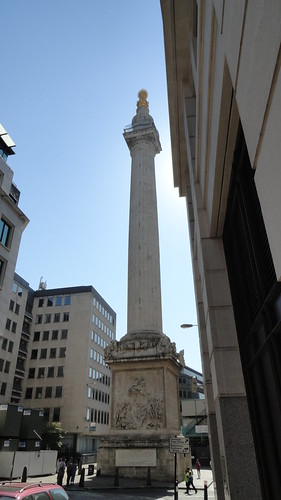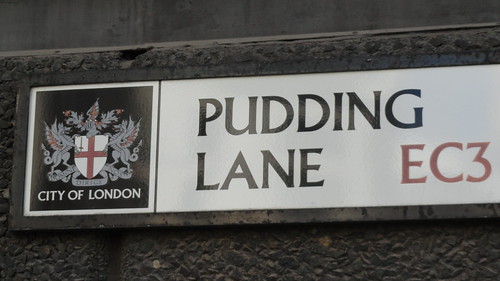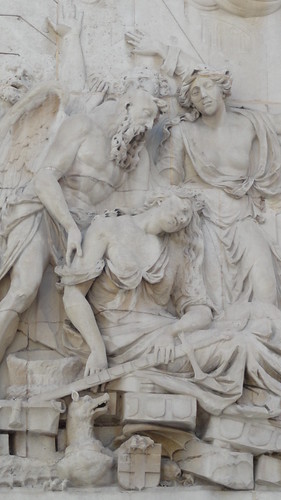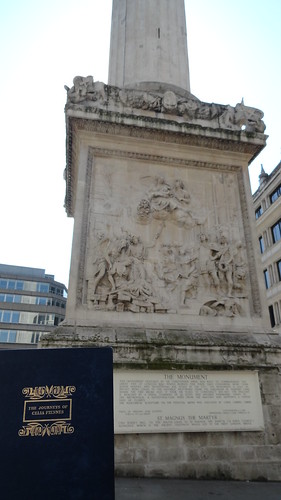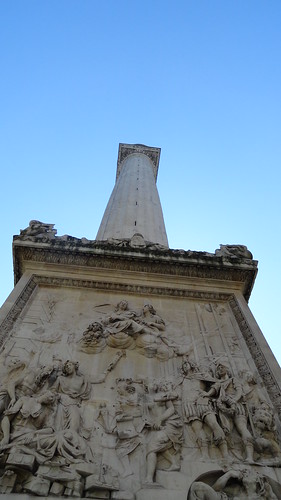I was extraordinarily fortunate to be doing my MA in London during the year which saw the Queen's Diamond Jubilee and the XXX Olympiad. What a year!
In the autumn of 2011 a landscape architect who worked on the design of the Olympic Park gave a presentation to our class; a design teaser of what was then being built. While I was writing my dissertation my tutor, Tom Turner, very generously gave me a ticket to the park so I was able to see it in all its Olympic glory (I can also boast that I ate at the World's Largest McDonald's). In this video Tom and fellow University of Greenwich professor Robert Holden, Landscape Architects both, discuss the post-Olympic landscape of the Queen Elizabeth Olympic Park. I would love to see it again, in light of this review.
Showing posts with label London. Show all posts
Showing posts with label London. Show all posts
13 July 2014
20 December 2013
5-10-5
I love reading interviews with gardeners. Being in the gardening world, as I am, and visiting so many amazing gardens, I always find myself wondering about the gardeners behind them: Where do they find their inspiration? What training have they had and from where? Why did they use a particular technique? What was their favorite tool? and If I asked nicely would they give me a cutting of that plant!?
One gardener who constantly inspires me is Jimmy McGrath, who is partly responsible for the path my own gardening life has taken in recent years. It was through him and his Longwood classmate, Mark, that I learned about the PG Program there. After Longwood Jimmy went to Great Dixter, where I met him one unusually snowy April morning. He went on to the Jerusalem Botanic Garden, then spent time gardening at DeWiersse in Holland. After a brief return to the States, Jimmy and his other half set off for England and I was able to reconnect with him there, chatting and catching up next to the colored fountains playing in the park next to Marble Arch that reminded us of the fountain terrace at Longwood. While in London, Jimmy worked on the fantastic landscape scenes featured in the Olympics opening ceremony - a once in a lifetime dream job! Then he was off to garden at Gravetye Manor, with the colors, forms, and textures of William Robinson's wild garden buffeting him with inspiration. Jimmy is a gifted artist and I always love when he posts his drawings on his blog, wishing I had the discipline to develop my own artistic ability more. Now he's gardening in Spain, enjoying the warm Mediterranean climate while I shiver through a cryogenic north east winter!
I have such admiration for Jimmy so I was truly surprised when he asked to interview me for a new blog that he and a friend here in the States were setting up. Me? Really? Aw, shucks! I don't know why I still find myself surprised by the way own garden path has meandered, and am constantly in awe of the company in which I find myself. Gardeners truly are remarkable people! So grab a cup of tea and go visit Jimmy's blog. There you will find beauty, art, horticulture, and inspiration.
Thanks, Jimmy! I'm proud to call you friend!
One gardener who constantly inspires me is Jimmy McGrath, who is partly responsible for the path my own gardening life has taken in recent years. It was through him and his Longwood classmate, Mark, that I learned about the PG Program there. After Longwood Jimmy went to Great Dixter, where I met him one unusually snowy April morning. He went on to the Jerusalem Botanic Garden, then spent time gardening at DeWiersse in Holland. After a brief return to the States, Jimmy and his other half set off for England and I was able to reconnect with him there, chatting and catching up next to the colored fountains playing in the park next to Marble Arch that reminded us of the fountain terrace at Longwood. While in London, Jimmy worked on the fantastic landscape scenes featured in the Olympics opening ceremony - a once in a lifetime dream job! Then he was off to garden at Gravetye Manor, with the colors, forms, and textures of William Robinson's wild garden buffeting him with inspiration. Jimmy is a gifted artist and I always love when he posts his drawings on his blog, wishing I had the discipline to develop my own artistic ability more. Now he's gardening in Spain, enjoying the warm Mediterranean climate while I shiver through a cryogenic north east winter!
I have such admiration for Jimmy so I was truly surprised when he asked to interview me for a new blog that he and a friend here in the States were setting up. Me? Really? Aw, shucks! I don't know why I still find myself surprised by the way own garden path has meandered, and am constantly in awe of the company in which I find myself. Gardeners truly are remarkable people! So grab a cup of tea and go visit Jimmy's blog. There you will find beauty, art, horticulture, and inspiration.
Thanks, Jimmy! I'm proud to call you friend!
Labels:
blogging,
gardening,
Gravetye Manor,
Great Dixter,
London,
Longwood,
Plinth et al,
William Robinson
04 July 2012
A Vast Prospect
In 1697 Celia Fiennes returned to London on (probably) what is now Shooter's Hill Road and the Old Dover Road. She wrote:
"...Shuttershill, on top of which hill you see a vast prospect ...some lands clothed with trees, others with grass and flowers, gardens, orchards, with all sorts of herbage and tillage, with severall little towns all by the river, Erith, Leigh, Woolwich etc., quite up to London, Greenwich, Deptford, Black Wall, the Thames twisting and turning it self up and down..."
I recently moved to this area and decided to explore a bit. I ended up at the top of this hill quite by accident and while the orchards and tillage have been consumed by urban sprawl, you can indeed still see quite up to London.
Way back in the hazy background on the left you can see the Shard, and in a larger view you can see the London Eye, the dome of St. Paul's, the Gherkin...pretty incredible. This area was once part of Kent, which is known as the 'garden of England', so just imagine what this view would look like with all those orchards and gardens and gibbets, herbage, &c. It's enough to make one sigh with nostalgia, isn't it?
(Wait, did she just say 'gibbets'?) Oh, yeah. This area was also notorious for being a preferred hangout (pun alert) for highwaymen. Such criminals were hung and left out to dry as a deterrent to others. It evidently worked for Samuel Pepys, who passed this way in April 1661: "Mrs. Anne and I rode under the man that hangs upon Shooter's Hill, and a filthy sight it was to see how his flesh is shrunk to his bones." Rather makes one wonder if that had anything to do with this choice of site for a cemetery. Hmmmm....
The area's name, I feel assured in saying, most certainly had everything to do with the choice of putting the Olympic shooting venue on Woolwich Common just outside the picture frame to the right, since the name Shooter's Hill comes from the Medieval practice of archery that took place here. That was reinforced by the anti-aircraft guns that were situted here during the Second World War. Pretty crafty of those Olympic people, what-what?
"...Shuttershill, on top of which hill you see a vast prospect ...some lands clothed with trees, others with grass and flowers, gardens, orchards, with all sorts of herbage and tillage, with severall little towns all by the river, Erith, Leigh, Woolwich etc., quite up to London, Greenwich, Deptford, Black Wall, the Thames twisting and turning it self up and down..."
I recently moved to this area and decided to explore a bit. I ended up at the top of this hill quite by accident and while the orchards and tillage have been consumed by urban sprawl, you can indeed still see quite up to London.
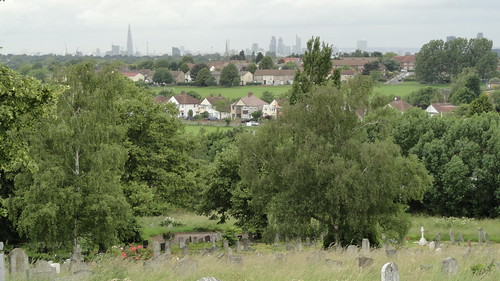 |
| Click to biggify |
Way back in the hazy background on the left you can see the Shard, and in a larger view you can see the London Eye, the dome of St. Paul's, the Gherkin...pretty incredible. This area was once part of Kent, which is known as the 'garden of England', so just imagine what this view would look like with all those orchards and gardens and gibbets, herbage, &c. It's enough to make one sigh with nostalgia, isn't it?
(Wait, did she just say 'gibbets'?) Oh, yeah. This area was also notorious for being a preferred hangout (pun alert) for highwaymen. Such criminals were hung and left out to dry as a deterrent to others. It evidently worked for Samuel Pepys, who passed this way in April 1661: "Mrs. Anne and I rode under the man that hangs upon Shooter's Hill, and a filthy sight it was to see how his flesh is shrunk to his bones." Rather makes one wonder if that had anything to do with this choice of site for a cemetery. Hmmmm....
The area's name, I feel assured in saying, most certainly had everything to do with the choice of putting the Olympic shooting venue on Woolwich Common just outside the picture frame to the right, since the name Shooter's Hill comes from the Medieval practice of archery that took place here. That was reinforced by the anti-aircraft guns that were situted here during the Second World War. Pretty crafty of those Olympic people, what-what?
Labels:
archery,
Celia Fiennes,
highwaymen,
London,
Olympics,
Samuel Pepys,
Shooter's Hill
24 June 2012
A Tale of Two Squares
 |
| Top: Leicester Square, London; photo taken around 9am on a Saturday Bottom: General Gordon Square, Woolwich; photo taken around 7pm on a Friday |
Sometimes fleeting impressions make the most lasting ones. Take these two squares, for example. The impressions were fleeting because I was just passing through, but lasting because of the stark contrast they formed in my mind.
Both squares have recently been redesigned as part of London's massive house-cleaning in preparation for the Olympics. Leicester Square has been around since 1635 when Lord Leicester purchased the land and built a house on it. The square was previously his front garden but had been common land before he bought it and had it enclosed. The parishioners appealed this enclosure and Lord L was made to keep that part of his land open. The actual square is still called Leicester Fields on the OS maps.
General Gordon Square is much newer, built in the late 1970's or early 80's after knocking down a bunch of buildings, including at least four public houses. Woolwich was once a great hub of military and industrial activity. I amused myself contemplating the pronunciation of Woolwich ('wool-itch'; the small w is silent) when I discovered that the etymological origin of the name actually means "trading place for wool". Go figure.
But let's examine them a little more closely. To commemorate the new Leicester Square, there's a plaque with a lot of blah-blah about the new and improved space being for public use and enjoyment. The design is clean with glistening new paving, shiny modern railings, and what appeared to be a diverting water feature surrounding the Shakespeare statue where jets of water spurt out of the pavement. The grass was green, the planting of box hedges was smelly, the trees provided a nice cool green shade. But something was missing. The square is meant for public use and enjoyment but other than the lady in the photo, there was no public presence. Granted, it was early on a weekend morning, but look closely and see if you notice what I did. This photo of the square in Victorian times should give you a clue:
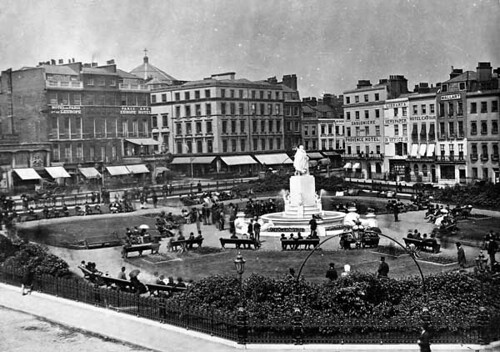 |
| Leicester Square c. 1880 (wiki) |
What I want to know about Leicester Square is: Where are the benches!? Where is the invitation to sit and linger? The way it is now, Leicester Square doesn't invite the public to linger and enjoy; the absence of a place to pause for said enjoyment means the square is nothing more than a conduit for people to pass through (as I did) on their hurried journey to someplace else. General Gordon Square, by contrast, has seating in plenty. The retaining walls framing the lawn areas do double duty so there is no lack of invitation to sit, relax, and enjoy the big screen telly.
 |
| The redesigned General Gordon Square (VolkerHighways.co.uk) |
Perhaps the benches for Leicester Square haven't arrived yet? Perhaps the designer has created seating to match the sparkling new railings and gates and are waiting for the metal to cool? Perhaps they just forgot? Either way, if I were to vote on which square was a success of public use and enjoyment, I'd have to go with Woolwich in spite of the questionable future of that RBBS (Really Big Big Screen). How about you?
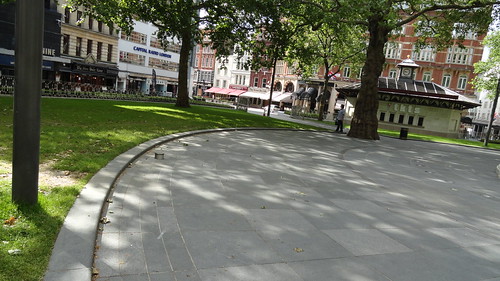 |
| What the new Leicester Square wants is a few places to sit. |
29 May 2012
Thence I Went: To The Monument
I've just spent a good amount of time working 16 hours a day, 7 days a week to finish my historic garden project. I'm pleased to report it's finally finished - finally! It was one of those situations where you invest so much of yourself into this one thing that when it's finally over, you sit there and sort of don't know what to do next and end up staring off into space, eyes glazed and jaw slacked (thank goodness I wasn't out in public!). Then a little voice inside my addled head whispered, "Now you've got a dissertation to write". Oh, yeah. That.
Now I get to turn my thoughts back to our intrepid traveller Celia Fiennes and the gardens she visited but felt after all that work I deserved at least a weekend off so on the first day, I slept. On the second day I decided to go see some London landmarks that Celia included in her journal. Celia went to live with relatives in London after her mother died in 1691 but obviously visited the city before then because she witnessed the coronations of James II (1685), William and Mary (1689), and Anne (1702) as well as the funeral processions of both Mary (1695) and William (1702). She describes the processions, the pomp, and the finery in quite a lot of detail which makes me eager to witness Queen Elizabeth II's Diamond Jubilee celebrations. Perhaps 300 years from now someone will stumble on my diary and read about it. Must take good note of things!
Well, to get my head properly in place, I went to London on a fine, sunny day and had this odd thought: I think I'll climb The Monument. I entreat you now, if ever I have the odd thought of climbing 311 stairs inside a 15-foot wide, 202-foot high free-standing fluted Doric column just for the fun of it, please slap me.
Of The Monument Celia says: There is alsoe at ye Bridge a Great Monument of stone worke...this is of a Great height 300 stepps up and on ye top gives ye view of ye whole town. This was sett up in memory of Gods putting a Check to ye Rageing flame wch by ye plotts and Contrivance of ye papists was Lighted. There is a Large Inscription on it all round mentioning it, and alsoe of ye popish plott and ye gun powdr treason and all by ye papists.
The Monument, or The Monument to the Great Fire of London, commemorates the Great Fire of 1666 which wiped out most of the Medieval City of London within the ancient Roman city walls.
Christopher Wren, one of the most highly acclaimed architects in history, designed The Monument. He also designed the new St. Paul's Cathedral, worked on a number of royal palaces, Westminster Abbey, the Greenwich Naval Hospital, and is generally credited with rebuilding London after the fire. Being also well-read in science, Wren designed the structure to double as a scientific instrument. The winding staircase's central shaft can be used as a zenith telescope (a hinged lid on the top of the structure covers the opening to the shaft).
As I climbed, huffing and puffing, I kept trying to imagine what it would have been like to attempt this monumental feat (pun absolutely intended) in a long skirt, petticoat, bodice, and corset (don't even get me started on the shoes), with no light but the knifes of sunlight through the slitted windows in the building (the steps are black, by the way, and even with modern lighting it's dark and dangerous up there!). The mind boggles. Still, I did it, and when I reached the top I was entertained to see climbers of yore had left their mark.
Celia was wrong, though, it's not 300 steps to the viewing platform 160 feet up, it's 311 and I climbed each and every one of them. She doesn't specifically state that she climbed to the top (she could have heard it from someone else) but I bet she did so we'll give her the benefit of the doubt. The view is still spectacular, but other than a few remaining landmarks, I don't think Celia would recognize the city.
I didn't scratch my name in the wall, but I did receive a nice commemorative certificate when I successfully made it back down (at which point my entire lower half turned to jelly). I spent about half an hour recovering on a bench conveniently located midway between The Monument and the spot at which the Great Fire started, at a baker's shop in Pudding Lane. If the management had any marketing sense, there would be a bakery there now instead of an ugly modern office building, selling Monument cakes and meringues shaped like Doric columns with little flames on top in yellow marzipan or edible gold leaf. Perhaps they could serve a refreshing and restorative draught called 'Fluted Fizz' which the public would appreciate, I'm sure, after such an exhausting accomplishment.
After that climb I was ready for a nice long sit and a cup of tea. It's been a few days and my thighs still scream when they encounter a staircase so I might wait a bit before attempting something like this again. Still, if you're one of those who likes to tick boxes on a list then a climb to the top is a must when you're seeing the sights of London. If Celia and I can do it, so can you!
Things To Know:
The Monument sits at the intersection of Monument Street and Fish Hill Street just north of London Bridge. The nearest tube stop is London Bridge. Exit the station and take the Tower Bridge Walk across the bridge. Keep going north, you'll spy it towering above you on the right.
The Monument is open daily from 9:30am to 6:00pm (last admission is 5:30pm). Prices are £3.00 for adults, £2.00 concessions (like students), and £1.50 child. There's a special combined ticket with The Tower Bridge Exhibition for £9, £6.20, and £4. Read more of its history and restoration here: http://www.themonument.info/.
After your adventure, head to Borough Market on the south end of London Bridge and treat yourself to a coffee and fresh pastry or cake. You've already worked them off!
Now I get to turn my thoughts back to our intrepid traveller Celia Fiennes and the gardens she visited but felt after all that work I deserved at least a weekend off so on the first day, I slept. On the second day I decided to go see some London landmarks that Celia included in her journal. Celia went to live with relatives in London after her mother died in 1691 but obviously visited the city before then because she witnessed the coronations of James II (1685), William and Mary (1689), and Anne (1702) as well as the funeral processions of both Mary (1695) and William (1702). She describes the processions, the pomp, and the finery in quite a lot of detail which makes me eager to witness Queen Elizabeth II's Diamond Jubilee celebrations. Perhaps 300 years from now someone will stumble on my diary and read about it. Must take good note of things!
Well, to get my head properly in place, I went to London on a fine, sunny day and had this odd thought: I think I'll climb The Monument. I entreat you now, if ever I have the odd thought of climbing 311 stairs inside a 15-foot wide, 202-foot high free-standing fluted Doric column just for the fun of it, please slap me.
Of The Monument Celia says: There is alsoe at ye Bridge a Great Monument of stone worke...this is of a Great height 300 stepps up and on ye top gives ye view of ye whole town. This was sett up in memory of Gods putting a Check to ye Rageing flame wch by ye plotts and Contrivance of ye papists was Lighted. There is a Large Inscription on it all round mentioning it, and alsoe of ye popish plott and ye gun powdr treason and all by ye papists.
The Monument, or The Monument to the Great Fire of London, commemorates the Great Fire of 1666 which wiped out most of the Medieval City of London within the ancient Roman city walls.
 |
| A Plan of the City and Liberties of London, Shewing the Extent of the Dreadful Conflagration in the Year 1666 by John Noorthouck 1772 (mapco.net) |
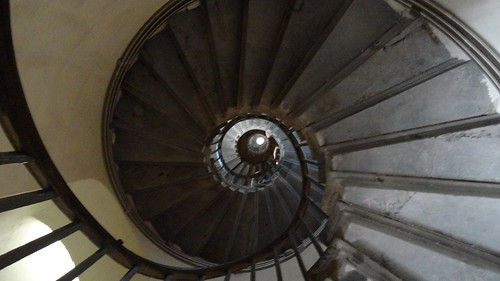 |
| The start of my ascent |
As I climbed, huffing and puffing, I kept trying to imagine what it would have been like to attempt this monumental feat (pun absolutely intended) in a long skirt, petticoat, bodice, and corset (don't even get me started on the shoes), with no light but the knifes of sunlight through the slitted windows in the building (the steps are black, by the way, and even with modern lighting it's dark and dangerous up there!). The mind boggles. Still, I did it, and when I reached the top I was entertained to see climbers of yore had left their mark.
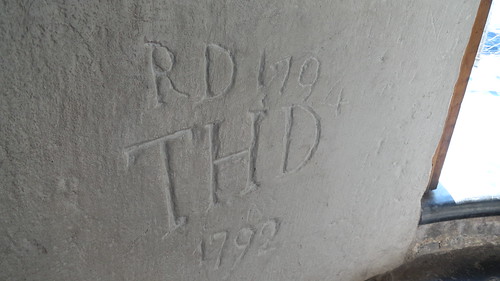 |
| Antique graffiti (the top says, "RD 1794", the bottom, "THD 1792") |
Celia was wrong, though, it's not 300 steps to the viewing platform 160 feet up, it's 311 and I climbed each and every one of them. She doesn't specifically state that she climbed to the top (she could have heard it from someone else) but I bet she did so we'll give her the benefit of the doubt. The view is still spectacular, but other than a few remaining landmarks, I don't think Celia would recognize the city.
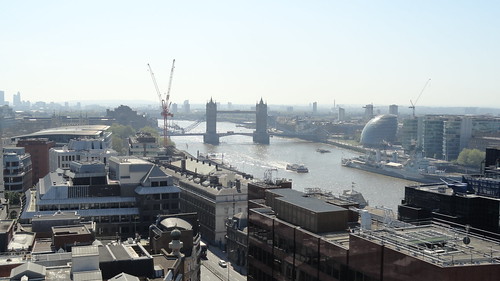 |
| The Tower of London was there in Celia's time but the iconic Tower Bridge wasn't begun until nearly a century later, in 1886. |
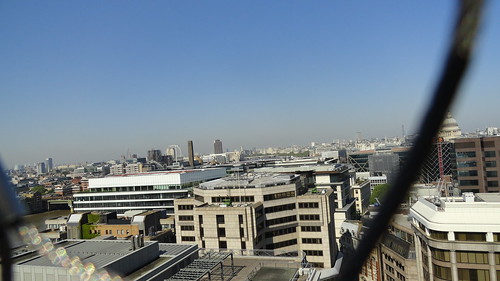 |
| The dome of St. Paul's (just visible behind the protective wire cage) wasn't complete until 1711 so depending on when Celia climbed these steps, she may or may not have seen the dome. |
I didn't scratch my name in the wall, but I did receive a nice commemorative certificate when I successfully made it back down (at which point my entire lower half turned to jelly). I spent about half an hour recovering on a bench conveniently located midway between The Monument and the spot at which the Great Fire started, at a baker's shop in Pudding Lane. If the management had any marketing sense, there would be a bakery there now instead of an ugly modern office building, selling Monument cakes and meringues shaped like Doric columns with little flames on top in yellow marzipan or edible gold leaf. Perhaps they could serve a refreshing and restorative draught called 'Fluted Fizz' which the public would appreciate, I'm sure, after such an exhausting accomplishment.
On three sides of the 40-foot high pedestal are inscriptions in Latin and a bas relief sculpture by Caius Gabriel Cibber depicting the destruction and resurrection of the city. And the bit about the Papists starting the fire - well, that has to do with the Popish Plot, an imaginary anti-Catholic conspiracy cooked up around 1678 and 1781 that had the country in a bit of a frenzy. The last words of the inscription on the Monument that Celia refers to were added after the fact, in 1681, and erased in 1830.
 |
| Sculpture on the west face of the pedestal, by Cibber |
 |
| Above are two goddesses, one with the cornucopia of Plenty and the other with the branch of Peace. It's hard to tell in the photo, but beneath her foot is a beehive denoting Industry. |
After that climb I was ready for a nice long sit and a cup of tea. It's been a few days and my thighs still scream when they encounter a staircase so I might wait a bit before attempting something like this again. Still, if you're one of those who likes to tick boxes on a list then a climb to the top is a must when you're seeing the sights of London. If Celia and I can do it, so can you!
Things To Know:
The Monument sits at the intersection of Monument Street and Fish Hill Street just north of London Bridge. The nearest tube stop is London Bridge. Exit the station and take the Tower Bridge Walk across the bridge. Keep going north, you'll spy it towering above you on the right.
The Monument is open daily from 9:30am to 6:00pm (last admission is 5:30pm). Prices are £3.00 for adults, £2.00 concessions (like students), and £1.50 child. There's a special combined ticket with The Tower Bridge Exhibition for £9, £6.20, and £4. Read more of its history and restoration here: http://www.themonument.info/.
After your adventure, head to Borough Market on the south end of London Bridge and treat yourself to a coffee and fresh pastry or cake. You've already worked them off!
London Garden History Walk
OK, I'm a little late since the Chelsea Flower Show ended on Saturday, but it's never too late to get a copy of Tom (my tutor) Turner's London Gardens Walk. It's an eBook containing a map with a 30km walk, cycle, or ride route to places in London which illustrate different eras and styles of garden history. It was published to coincide with this year's first annual Chelsea Fringe festival, which is still going even though the flower show is over.
The printable .pdf route map includes sites of the Fringe festivities so if you're in London for Chelsea or the Jubilee (I'm getting a wee bit excited about that, aren't you!?), there's still time to catch these events.
For more info on both the London Gardens Walk and Chelsea Fringe 2012, check out these websites:
www.gardevisit.com and www.chelseafringe.com
The printable .pdf route map includes sites of the Fringe festivities so if you're in London for Chelsea or the Jubilee (I'm getting a wee bit excited about that, aren't you!?), there's still time to catch these events.
For more info on both the London Gardens Walk and Chelsea Fringe 2012, check out these websites:
www.gardevisit.com and www.chelseafringe.com
Labels:
Chelsea Fringe,
Garden History,
London,
London Garden Walk
Subscribe to:
Posts (Atom)
